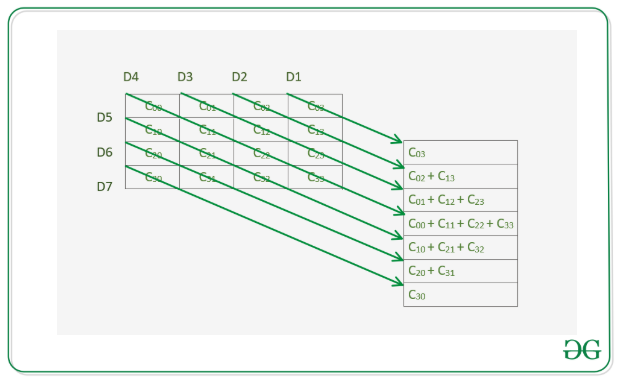给定尺寸为N * N的方阵mat [] [] ,任务是沿着平行于主对角线的对角线找到给定矩阵中存在的元素的最大和。下面是相同的图像。

例子:
Input: mat[][] = {{1, 2, 5, 7}, {2, 6, 7, 3}, {12, 3, 2, 4}, {3, 6, 9, 4}}
Output: 18
Explanation:
Sum of elements present in the diagonal having cells (2, 0) and (3, 1) is 12 + 6 = 18 which is maximum among all diagonals.
Input: mat[][] = {{5, 2, 5, 7}, {2, 5, 7, 3}, {12, 3, 5, 4}, {3, 6, 9, 5}}
Output: 18
Explanation:
Sum of elements present in the main diagonal having cells (0, 0), (1, 1), (2, 2) and (3, 3) is 5 + 5 + 5 + 5 = 20 which is maximum among all diagonals.
方法:想法是遍历与主对角线平行的每个对角线的像元,并观察到,主对角线上方的任何对角线从像元(x,y)开始,对应于主对角线以下的对角线将从像元开始(y,x) 。对于每个对角线,从像元(x,y)开始,其所有元素都将位于像元(x + k,y + k)上,其中0 <= x + k,y + k
- 将变量maxSum初始化为0 ,该变量将存储最大对角线总和。
- 从i遍历[0,N – 1]的第0行的列。
- 初始化变量sum1和sum2 ,它们将分别存储从单元格(行,col)和从单元格(col,行)开始的对角线总和,其中r为0,c为col 。
- 将row和c都增加1 。当row和col小于N时,将mat [row] [col]添加到sum1并将mat [col] [row]添加到sum2 。最后,更新maxSum以存储maxSum,sum1和sum2的最大值。
- 遍历给定矩阵后,将值maxSum打印为最大和。
下面是上述方法的实现:
C++
// C++ program for the above approach
#include
using namespace std;
// Function to return maximum diagonal
// sum that are parallel to main diagonal
int maxDiagonalSum(vector > arr, int N)
{
// Initialize maxSum
int maxSum = 0;
// Traverse through the columns
for (int i = 0; i < N; i++) {
// Initialize r and c
int row = 0, col = i;
// Diagonal sums
int sum1 = 0, sum2 = 0;
while (col < N && row < N) {
sum1 += arr[row][col];
sum2 += arr[col][row];
row++;
col++;
}
// Update maxSum with
// the maximum sum
maxSum = max({ sum1, maxSum, sum2 });
}
// Return the maxSum
return maxSum;
}
// Driver Code
int main()
{
// Given matrix mat[][]
vector > mat
= { { 1, 2, 5, 7 },
{ 2, 6, 7, 3 },
{ 12, 3, 2, 4 },
{ 3, 6, 9, 4 } };
int N = mat.size();
// Function Call
cout << maxDiagonalSum(mat, N);
return 0;
} Java
// Java program for the above approach
import java.io.*;
class GFG{
// Function to return maximum diagonal
// sum that are parallel to main diagonal
static int maxDiagonalSum(int arr[][], int N)
{
// Initialize maxSum
int maxSum = 0;
// Traverse through the columns
for(int i = 0; i < N; i++)
{
// Initialize r and c
int row = 0, col = i;
// Diagonal sums
int sum1 = 0, sum2 = 0;
while (col < N && row < N)
{
sum1 += arr[row][col];
sum2 += arr[col][row];
row++;
col++;
}
// Update maxSum with
// the maximum sum
maxSum = Math.max(maxSum,
Math.max(sum1,
sum2));
}
// Return the maxSum
return maxSum;
}
// Driver code
public static void main (String[] args)
{
// Given matrix mat[][]
int mat[][] = { { 1, 2, 5, 7 },
{ 2, 6, 7, 3 },
{ 12, 3, 2, 4 },
{ 3, 6, 9, 4 } };
int N = mat.length;
// Function Call
System.out.println(maxDiagonalSum(mat, N));
}
}
// This code is contributed by math_loverPython3
# Python3 program for the above approach
# Function to return maximum diagonal
# sum that are parallel to main diagonal
def maxDiagonalSum(arr, N):
# Initialize maxSum
maxSum = 0
# Traverse through the columns
for i in range(N):
# Initialize r and c
row = 0
col = i
# Diagonal sums
sum1 = 0
sum2 = 0
while col < N and row < N:
sum1 += arr[row][col]
sum2 += arr[col][row]
row += 1
col += 1
# Update maxSum with
# the maximum sum
maxSum = max([ sum1, maxSum, sum2])
# Return the maxSum
return maxSum
# Driver Code
if __name__ == '__main__':
# Given matrix mat[][]
mat = [ [ 1, 2, 5, 7 ],
[ 2, 6, 7, 3 ],
[ 12, 3, 2, 4 ],
[ 3, 6, 9, 4 ] ]
N = len(mat)
# Function Call
print(maxDiagonalSum(mat, N))
# This code is contributed by mohit kumar 29C#
// C# program for the
// above approach
using System;
class GFG{
// Function to return maximum
// diagonal sum that are parallel
// to main diagonal
static int maxDiagonalSum(int [,]arr,
int N)
{
// Initialize maxSum
int maxSum = 0;
// Traverse through the
// columns
for(int i = 0; i < N; i++)
{
// Initialize r and c
int row = 0, col = i;
// Diagonal sums
int sum1 = 0, sum2 = 0;
while (col < N && row < N)
{
sum1 += arr[row,col];
sum2 += arr[col,row];
row++;
col++;
}
// Update maxSum with
// the maximum sum
maxSum = Math.Max(maxSum,
Math.Max(sum1,
sum2));
}
// Return the maxSum
return maxSum;
}
// Driver code
public static void Main(String[] args)
{
// Given matrix [,]mat
int [,]mat = {{1, 2, 5, 7},
{2, 6, 7, 3},
{12, 3, 2, 4},
{3, 6, 9, 4}};
int N = mat.GetLength(0);
// Function Call
Console.WriteLine(maxDiagonalSum(mat, N));
}
}
// This code is contributed by gauravrajput1Javascript
18时间复杂度: O(N 2 )
辅助空间: O(N 2 )